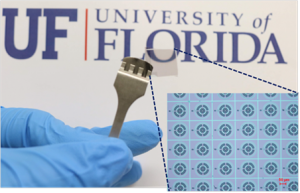
In a new paper published in Nature’s Microsystems and Nanoengineering, a team led by Dr. Roozbeh Tabrizian and Dr. Swarup Bhunia has demonstrated a novel product-labeling approach based on resonant nano-electro-mechanical systems (NEMS). This technology substantially surpasses fundamental limitations of current labeling systems for product identification and authentication. The new technology enables clandestine integration of nano-scale wireless identification labels on a variety of products in four major categories: (1) electronics; (2) plastic/glass objects; (3) documents (passports, photos, paintings, tickets, and currency); (4) and food/pharmaceuticals.
The Background
The global threat of product counterfeiting continues to expand in scope, and in recent years, the challenge of developing effective and secure identification and authentication approaches has become more and more critical. Counterfeiting attacks affect the global supply chain by targeting a wide range of goods, including consumer electronic systems, currency, medicine, and food products. The growing complexity of globally distributed supply chains for the majority of products increases their vulnerability to counterfeiting.
Besides the large-scale economic effects of counterfeiting, the global trade of specific counterfeit goods—such as food, medicine and pesticides—carries with it serious health and safety implications. More than ever, the security of global supply chain depends upon protection from the destructive effects of counterfeiting attacks. In response, various identification and authentication techniques have historically been used to enable traceability of genuine products and identification of their fake counterparts. These techniques include: universal product code (UPC) barcodes, quick response (QR) codes, and radio-frequency identification tags (RFID). Such techniques rely on the designation of a digital label, through the physics of a specific operation, to a physical tag that is attached or imprinted on the product. The digital label (and the physics process upon which it relies) enables traceability and authentication of the host.
Although relatively successful in controlling and combatting the growth of counterfeiting, these methods suffer from fundamental limitations that make a label susceptible to cloning, tampering, damage/distortion, and abolishment.
A Novel Approach
 According to Dr. Tabrizian, “the novel nano-scale labels operate based on the intentional or randomized encryption of a digital string in the spectral signature of a resonant NEMS. The spectral signature of the NEMS label contains several high quality-factor peaks at different frequencies that correspond to different natural mechanical resonance modes of the label. These peaks can be detected through wireless interrogation of the label using low-power wideband electromagnetic readers (a mobile phone phone app or another type of customized wireless reader). The interrogated spectral signature of the NEMS label is then translated to a digital string through specialized interpretation software.”
According to Dr. Tabrizian, “the novel nano-scale labels operate based on the intentional or randomized encryption of a digital string in the spectral signature of a resonant NEMS. The spectral signature of the NEMS label contains several high quality-factor peaks at different frequencies that correspond to different natural mechanical resonance modes of the label. These peaks can be detected through wireless interrogation of the label using low-power wideband electromagnetic readers (a mobile phone phone app or another type of customized wireless reader). The interrogated spectral signature of the NEMS label is then translated to a digital string through specialized interpretation software.”
As Dr. Bhunia explains, “this disruptive wireless ID technology possesses is unique in its ultra-miniaturized size and optical transparency, which makes it extremely challenging to be located, cloned, tampered with, or removed.” Dr. Tabrizian adds, “an additional benefit to the system is the low cost of production of the labels—the semiconductor batch manufacturing process enables creation of a millions of labels in a single run.”
The unique features of the clandestine NEMS labels make it suitable for creating both watermarks (same labels for all instances of a product type) as well as fingerprints (unique label for each instance of a product). The UF team believes this technology can transform product authentication and identification approaches and significantly improve the immunity of supply-chain to malicious counterfeiting attacks.
The article was published Nov. 30.
Dr. Tabrizian is an assistant professor and the Alan Hastings Faculty Fellow at ECE Florida. Dr. Bhunia is the Semmoto Endowed Professor and director of the Warren B. Nelms Institute for the Connected World.